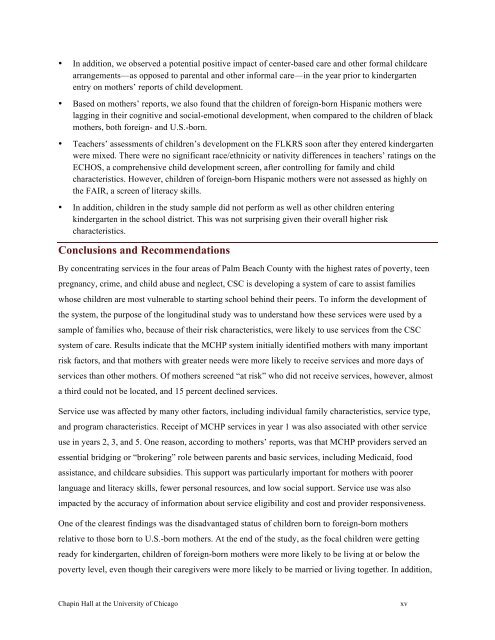2011 The Palm Beach County Family Study (Full Report)
2011 The Palm Beach County Family Study (Full Report)
2011 The Palm Beach County Family Study (Full Report)
- No tags were found...
Create successful ePaper yourself
Turn your PDF publications into a flip-book with our unique Google optimized e-Paper software.
• In addition, we observed a potential positive impact of center-based care and other formal childcarearrangements—as opposed to parental and other informal care—in the year prior to kindergartenentry on mothers’ reports of child development.• Based on mothers’ reports, we also found that the children of foreign-born Hispanic mothers werelagging in their cognitive and social-emotional development, when compared to the children of blackmothers, both foreign- and U.S.-born.• Teachers’ assessments of children’s development on the FLKRS soon after they entered kindergartenwere mixed. <strong>The</strong>re were no significant race/ethnicity or nativity differences in teachers’ ratings on theECHOS, a comprehensive child development screen, after controlling for family and childcharacteristics. However, children of foreign-born Hispanic mothers were not assessed as highly onthe FAIR, a screen of literacy skills.• In addition, children in the study sample did not perform as well as other children enteringkindergarten in the school district. This was not surprising given their overall higher riskcharacteristics.Conclusions and RecommendationsBy concentrating services in the four areas of <strong>Palm</strong> <strong>Beach</strong> <strong>County</strong> with the highest rates of poverty, teenpregnancy, crime, and child abuse and neglect, CSC is developing a system of care to assist familieswhose children are most vulnerable to starting school behind their peers. To inform the development ofthe system, the purpose of the longitudinal study was to understand how these services were used by asample of families who, because of their risk characteristics, were likely to use services from the CSCsystem of care. Results indicate that the MCHP system initially identified mothers with many importantrisk factors, and that mothers with greater needs were more likely to receive services and more days ofservices than other mothers. Of mothers screened “at risk” who did not receive services, however, almosta third could not be located, and 15 percent declined services.Service use was affected by many other factors, including individual family characteristics, service type,and program characteristics. Receipt of MCHP services in year 1 was also associated with other serviceuse in years 2, 3, and 5. One reason, according to mothers’ reports, was that MCHP providers served anessential bridging or “brokering” role between parents and basic services, including Medicaid, foodassistance, and childcare subsidies. This support was particularly important for mothers with poorerlanguage and literacy skills, fewer personal resources, and low social support. Service use was alsoimpacted by the accuracy of information about service eligibility and cost and provider responsiveness.One of the clearest findings was the disadvantaged status of children born to foreign-born mothersrelative to those born to U.S.-born mothers. At the end of the study, as the focal children were gettingready for kindergarten, children of foreign-born mothers were more likely to be living at or below thepoverty level, even though their caregivers were more likely to be married or living together. In addition,Chapin Hall at the University of Chicagoxv
















